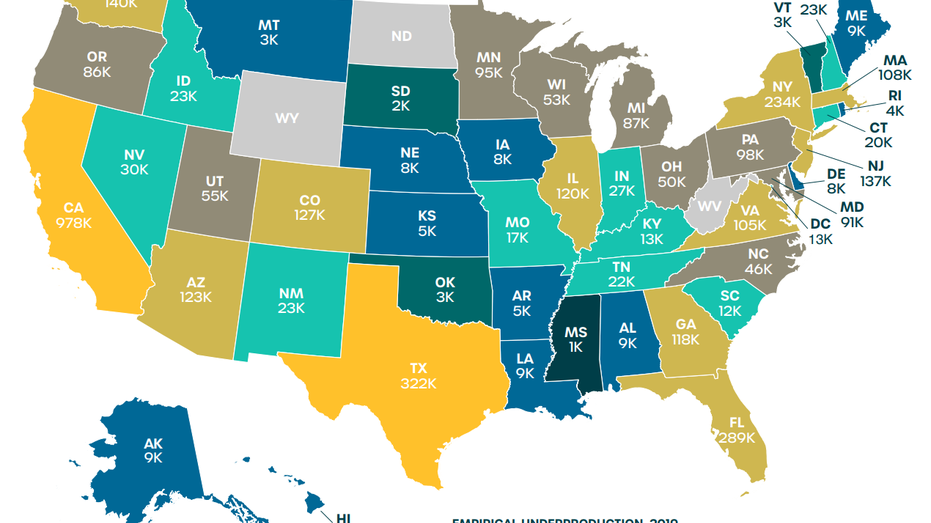U.S. housing market's underproduction crisis getting worse, new analysis finds
The U.S. homes deficit doubled from 1.65 million to 3.8 million between 2012 and 2019: Up For Growth
Housing market will ‘inevitably’ come down: Tech expert
Disruptive Tech Research founder and chief analyst Lou Basenese weighs in on the housing market and the overall state of the economy on ‘Varney & Co.’
Up For Growth, a non-profit committed to solving the United States' housing shortage, is sounding the alarm on the nation's underproduction of homes.
According to a study released by the organization on Thursday, the U.S. homes deficit more than doubled between 2012 and 2019 from 1.65 million to 3.8 million.
In 2012, the nation’s affordability problem appeared to be concentrated on the coasts and in the Southwest. However, Up for Growth has identified a housing deficit in a total of 47 states and the District of Columbia as of 2019.

Housing Underproduction, 2019: Up For Growth
The study found that the average U.S. state had a housing deficit of 79,000 homes in 2019.
HOME LOAN SIZE RETREATS FROM RECORD AS MORTGAGE APPLICATION DEMAND COOLS
California led the housing gap with a shortage of 980,000 homes, followed by Texas with 322,000 homes, Florida with 289,000 homes and New York with 234,000 homes.
Other states with severe housing underproduction in 2019 included Washington, New Jersey, Colorado, Arizona, Illinois, Georgia, Massachusetts, Virginia, Minnesota, Oregon and Utah. Six new states added to the underproduction list since 2012 include Mississippi, Missouri, Nevada, Oklahoma, Rhode Island and South Carolina.

Lumber at the site of a house under construction in the Cielo at Sand Creek by Century Communities housing development in Antioch, California, U.S., on Thursday, March 31, 2022. (Photographer: David Paul Morris/Bloomberg via Getty Images / Getty Images)
Housing underproduction affected 169 metropolitan areas in 2019, up from 100 in 2012. The deficit became more severe in 230 cities in 2019 compared to 2012.
Metro areas with the most severe housing underproduction in 2019 included Los Angeles, New York, Miami, Riverside (California), Washington D.C., Chicago, San Francisco, Phoenix, Atlanta and Philadelphia.
Only 25 metros experienced an improvement in underproduction, or a shrinking housing deficit, since 2012.
HOME SALE CANCELLATIONS HIT HIGHEST RATE SINCE START OF PANDEMIC
In order to help solve the housing shortage, Up For Growth has called for the adoption of its Better Foundation framework, which seeks to create more homes in areas with high economic mobility, access to jobs and existing infrastructure.
Up for Growth estimates that building 3.8 million additional homes through the Better Foundation framework could result in a total of $117 billion in savings for U.S. households after 20 years, or an average of $3,000 per year.
After 30 years of production, the plan is expected to generate an additional $209 billion in U.S. gross domestic product, $111 billion in personal income, $7 billion in net revenue for local jurisdictions and $4.4 billion in federal revenue.
"It is vital that we act now to address America’s most urgent economic, environmental and social equity crisis," Up for Growth CEO Mike Kingsella said in a statement.
CLICK HERE TO READ MORE ON FOX BUSINESS
For the week ending July 9, active housing inventory grew 28% compared to a year ago, according to Realtor.com. The shift comes as several weeks of new listings coming online boosted inventory levels by almost a third compared to a year ago.
"Real estate markets remain undersupplied compared with 2019, but they are moving in the right direction," Realtor.com senior economist George Raitu said in a statement.
The median listing price advanced by 15.9% over last year, continuing an upward trend at a double-digit yearly pace for a 30th consecutive week. However, listing price growth is on a downward trend, moving below the pace seen in late May and early June.
Realtor.com expects to see home price growth continue ease in the coming weeks and slow in the second half of 2022.





















